Journeys with an Apostle
Second Mission - Corinth
Rome’s command post in Greece …
In the New Testament yarn Paul visited Corinth on his second missionary journey, stayed eighteen months and founded the Corinthian church. He supposedly returned to Greece – one assumes to the city of Corinth – for three months on his third mission. Two letters ostensibly written to the Christians of Corinth form part of the core of “authentic” Pauline epistles and shore up the historical claims of Christianity.
In Corinth, above all places on the apostle’s various itineraries, defenders of the faith muster “historical markers” to corroborate the instructional tale of early evangelism and nascent discord in the Church of God.
Yet if we are not blinded by the conviction that the Corinthian episode is an obvious truth requiring no examination of the evidence, we can recognize the high probability that the apostle’s residence in the city is entirely a matter of fable, and that the true authorship of the Corinthian epistles is rather more problematic than is generally supposed.
Dreamscape
“The church at Corinth clearly got off to a flying start … These conversions happened so quickly that they must be understood to have been the result of a carefully thought-out strategy.”
– Murphy O’Connor, Paul, His Story, p86.
Paul’s careful strategy?
An unknown Jewish religious emissary arrives in a large and bustling Roman port city. By happenstance he encounters fellow Jews who share his trade, can employ his skills and also offer him accommodation. Our emissary is a sectarian of a novel and miniscule faction within Judaism and – glory be! – it emerges so too are his new friends and employers. Unwelcome in the synagogue where he tries to win converts, he is able to set-up shop next door because an early neophyte happens to live “hard to” the synagogue. The vociferous Jews of the city reject his message – all that is, except the very leader of the synagogue – and it would seem the man who replaces him. Our charmed preacher escapes arraignment before the provincial governor and continues his mission. His success is not confined to wealthy Jews. The pagan city treasurer is also won over, even running errands for our proselytizer to far off cities. A thriving church is established and our bold evangelist moves on with his “good news” to pastures new.
Corinth – A vibrant Roman colony
– Strabo, Geography, 8.6.23. c.23 AD.
– Pausanias, Periegesis Hellados, 2.1.2., c.150 AD.
Corinth at the time of Paul was not a Greek city but a Roman colony and only scant traces of the earlier Greek city have ever been found.
Were there Jews in Corinth? Was there a synagogue?
Yet Pausanius, in all this punctilious catalogue of piety, neither mentions nor so much as hints at either a “Christian meeting house” or a synagogue of the Jews. And this is in the mid-2nd century when the “Church of Corinth” should have been very much a going concern.
Is it possible that the bold evangelist – or at least the writer of the so-called letters to the Corinthians – never strolled into Corinth at all?
Downtown Corinth, 1st century AD – awash with pagan piety
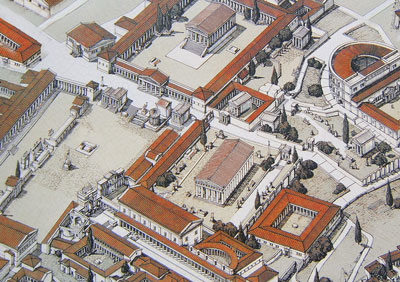
Centre top: Temple of Octavia (sister to Augustus).
Centre: Temple of Apollo
West side of forum: Temples of Tyche, Klarios Apollo, Herakleos, Poseidon, Hermes.
On north-south thoroughfare: Temple of Hera.
But no church – and no synagogue – though a fanciful Christian “tradition” promotes the notion that a Christian meeting house was “near the Peirene fountain” (lower left).
Vespasian's gift to Greece – the Jews
“In Achaia Nero attempted to cut through the Isthmus and called together the praetorians and urged them to begin the work; then at a signal given on a trumpet he was first to break ground with a mattock and to carry off a basketful of earth upon his shoulders.”
– Suetonius, Nero, 19
“On the tour through Greece, among the companions of Nero, Vespasian bitterly offended the emperor by either going out often while Nero was singing, or falling asleep, if he remained. Being in consequence banished, not only from intimacy with the emperor but even with his public receptions, he withdrew to a little out‑of-the‑way town, until a province and an army were offered him while he was in hiding and in fear of his life.”
– Suetonius, Vespasian, 4.
“After this fight was over, Vespasian sat upon his tribunal at Taricheae … Out of the young men he chose six thousand of the strongest, and sent them to Nero, to dig through the Isthmus.“
– Josephus, War, 3.10.10.
Refugees from Rome?
“As for the Jews, who had again increased so greatly that by reason of their multitude it would have been hard without raising a tumult to bar them from the city, he did not drive them out, but ordered them, while continuing their traditional mode of life, not to hold meetings.”
– Dio, Roman History, 60.6.
However, the most detailed report of this period is found in Josephus and yet there is nothing to be found in Josephus of this expulsion of the Jews, although he does agree fully with Suetonius on the expulsion of Jews twenty years earlier by Tiberius, along with the Egyptian cults and astrologers (Suetonius, Tiberius 36; Josephus, Antiquities, 18.3.5.).
In 41 AD Claudius promulgated a decree confirming, not restricting, Jewish rights: “The Jews, who are in all the world under us, shall maintain their ancestral customs without hindrance” – a decree extant in several inscriptions. Josephus even reports that Agrippa “anointed his head with ointment” (hence “chrestos”) when he met the senate (Antiquities, 19.4.1) – a reference that may well have inspired a later Christian scribe to interpolate the nonsensical “Chrestus agitation”
Paul's miraculous conversions
“I came to you, came not with excellency of speech or of wisdom … not with enticing words of man’s wisdom, but in demonstration of the Spirit and of power.”
– 1 Corinthians 2.1,4.
“In nothing am I behind the very chiefest apostles, though I be nothing. Truly the signs of an apostle were wrought among you in all patience, in signs, and wonders, and mighty deeds.”.
– 2 Corinthians 12.11-12.
Did Paul beam at the bema?
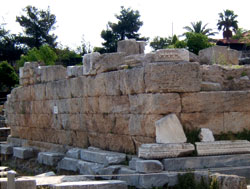
The Gallio Inscription is evidence of Gallio in Delphi but it is not evidence of Paul in Corinth.
“But when Paul was about to open his mouth, Gallio said unto the Jews, If indeed it were a matter of wrong or of wicked villainy, O ye Jews, reason would that I should bear with you: but if they are questions about words and names and your own law, look to it yourselves; I am not minded to be a judge of these matters. And he drove them from the judgment seat.”
– Acts 18.14,15.
The Name Game: Erastus
– Romans 16.23.
In 1929 an inscribed marble paving stone was discovered in the northeast corner of the theatre in Corinth. Dated to the second half of the first century, the inscription (originally inlaid with metal) read: ERASTVS PRO AED S P STRAVIT. This is an abbreviation of ERASTUS PRO AEDILITATE SUA PECUNIA STRAVIT and translates as “Erastus in return for his aedileship laid at his own expense.”

Christians and the Asklepieion
“The Aricians tell a tale that agrees with the inscription on this slab, that when Hippolytus was killed, owing to the curses of Theseus, Asclepius raised him from the dead.
“On coming to life again he refused to forgive his father rejecting his prayers, he went to the Aricians in Italy. There he became king and devoted a precinct to Artemis, where down to my time the prize for the victor in single combat was the priesthood of the goddess. The contest was open to no freeman, but only to slaves who had run away from their masters.”
– Pausanius, Periegesis Hellados, 2.27.4.
Sources:
- Bart Ehrman, Peter, Paul and Mary Magdalene (OUP, 2006)
- P. Themelis, Ancient Corinth (Hannibal, 2004)
- J. Stobart, The Glory that was Greece (Sidgwick & Jackson, 1964)
- W. Keller, The Bible as History (Hodder & Stoughton, 1969)
- E. Spatharis, K Petropoulou, Ancient Corinth (Olympic, 2006)
- N. H. Sitwell, Roman Roads of Europe (Cassell, 1981)
- J. Murphy-O’Connor, Paul, a Critical Life (Clarendon, 1996)
- J. Finegan, Light from the Ancient Past (Kessinger, 2007)
- A. N. Wilson, Paul – The Mind of the Apostle (Sinclair-Stevenson, 1997)
Related Articles:
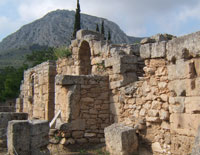
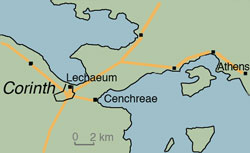
Rome in Greece
“After these things Paul departed from Athens, and came to Corinth.”
– Acts 18.1.
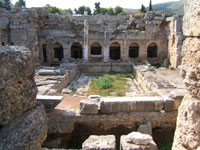
Roman grandeur
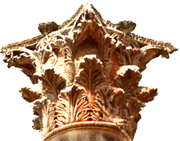
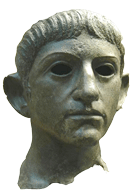
Claudius - friend of Jews
“Tiberius Claudius Caesar Augustus Germanicus, pontifex maximus, holding the tribunician power, proclaims: . . .Therefore it is right that also the Jews, who are in all the world under us, shall maintain their ancestral customs without hindrance and to them I now also command to use this my kindness rather reasonably and not to despise the religious rites of the other nations, but to observe their own laws.”
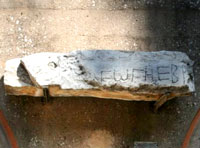
A Synagogue?
A Meat Market?

Jewish menorahs
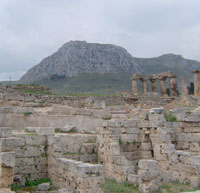
Holy hookers
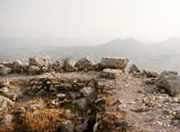
Paul meets Aquila and Prisca – fellow Jews, fellow Christians, fellow tent-makers!
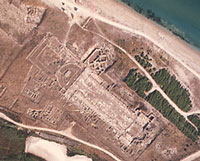
Lechaeum.
Lechaeum, on the Corinthian gulf, reputedly the third largest port in the empire, was equipped with shipyards and a naval station.
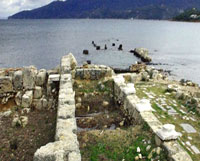
Cenchreae

Water nymphs
A God that Heals – Asclepius
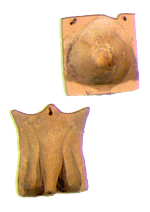
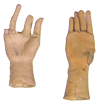
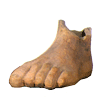
Hundreds of life size terra-cotta body parts have been recovered from ancient Corinth, votive offerings to the god Asclepius.
